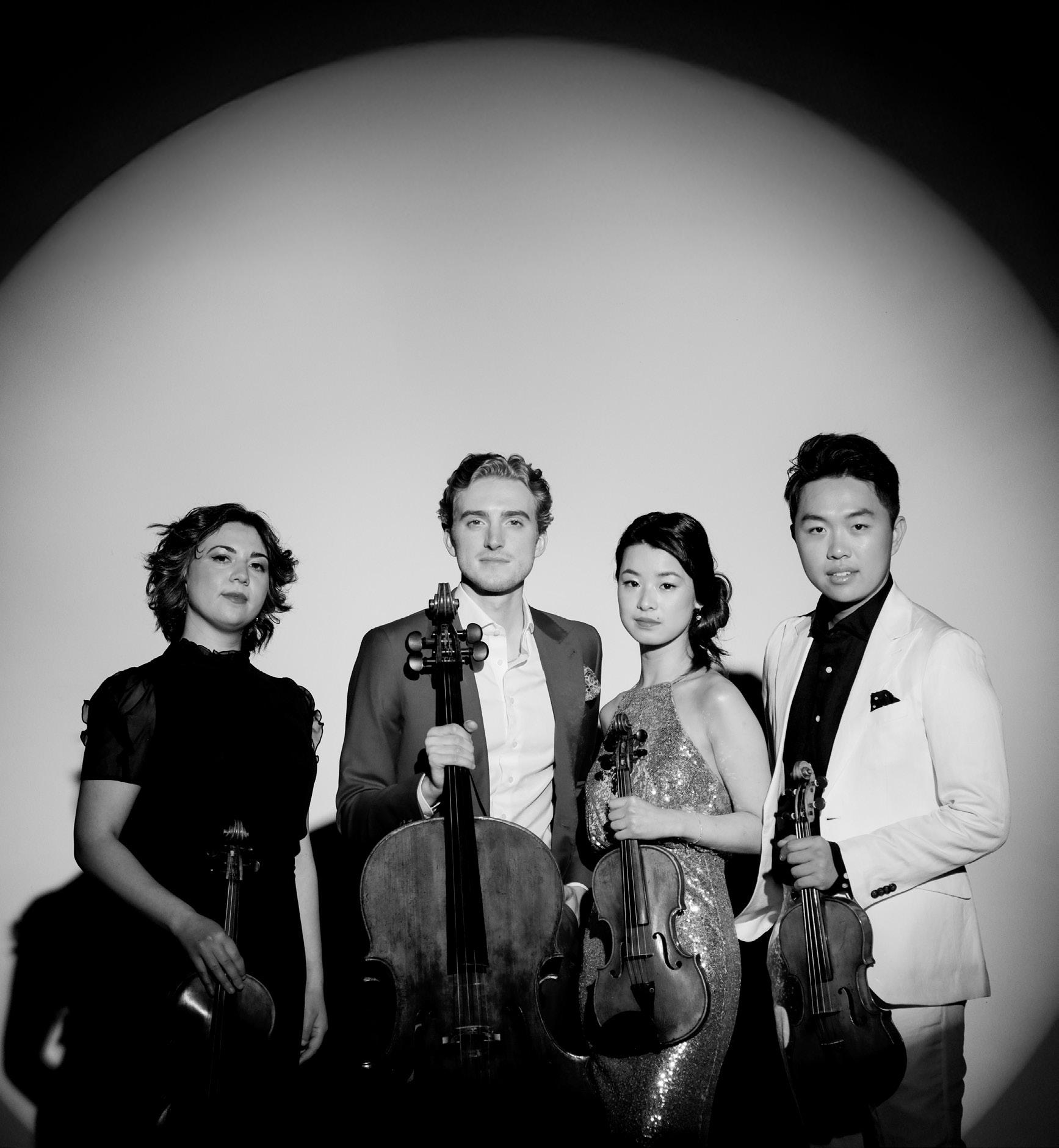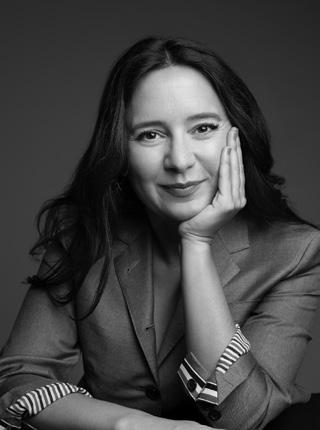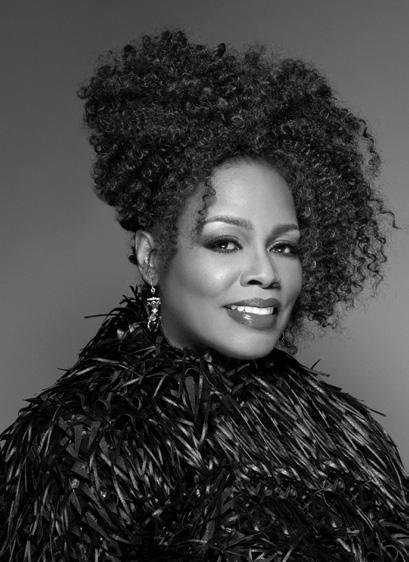
Sunday, November 16, 2025 at 3 pm



Sunday, November 16, 2025 at 3 pm

Presented in collaboration with

is made possible, in part,
JOSEPH HAYDN (1732–1809)
Quartet in D minor for Strings, Hob. III:83, Op. 103 (1803)
Andante grazioso
Menuet ma non troppo presto
ZHOU, WANG, KANE, ZAWADIUK
FELIX MENDELSSOHN (1809–1847)
Quartet in D major for Strings, Op. 44, No. 1 (1838)
Molto allegro vivace
Menuetto: Un poco allegretto
Andante espressivo ma con moto
Presto con brio
ZHOU, WANG, KANE, ZAWADIUK
JOHANNES BRAHMS (1833–1897)
Quintet in F minor for Piano, Two Violins, Viola, and Cello, Op. 34 (1864)
Allegro non troppo
Andante, un poco adagio
Scherzo: Allegro
Finale: Poco sostenuto—Allegro non troppo
KALISH, ZHOU, WANG, KANE, ZAWADIUK
JOSEPH HAYDN
Born March 31, 1732, in Rohrau, Lower Austria
Died May 31, 1809, in Vienna
Composed in 1803
Duration: 11 minutes
Across the nearly 70 quartets that preceded the piece heard today, Haydn defined the genre, earning him the nickname “the father of the string quartet.” He established many of the characteristics that we associate with the traditional string quartet, including the four-movement structure with fast outer movements framing a slow movement and a minuet.
In the late 1790s Haydn was occupied with a number of projects, including large-scale sacred vocal compositions. Despite juggling several major works, he accepted a commission from Prince Franz Lobkowitz for a string quartet cycle. The first two Lobkowitz quartets, Op. 77, Nos. 1 and 2, were completed in 1799. Haydn would not return to the genre for a few years, overwhelmed by other commitments and battling declining physical and mental health. Pressured by publishing conventions of the time to complete at least three of the six promised pieces, Haydn pivoted to composing this D-minor quartet. The inner movements heard today were completed by the summer of 1803, but he was ultimately unable to finish the work due to his health. In a letter to a publisher from 1799, Haydn, then 67, wrote of the difficulties he was starting to face:
“Every day the world compliments me on the fire of my recent works, but no one will believe the strain and effort it costs me to produce them. Some days my enfeebled memory and the unstrung state of my nerves crush me to the earth to such an extent that I fall prey to the worst sort of depression[.]”
In December of 1802, he wrote to another editor: “I only wish that I could have back ten years of my advanced age, so that I could provide you with something new of my composition— perhaps, despite everything—it can still happen.” And indeed, it did: though not a complete work, these two movements showcase Haydn’s artistry and skill when it comes to the quartet genre.
The Andante grazioso is simple and elegant. Its lyrical opening theme establishes a warm texture in the key of B-flat major. The middle section deviates from the standard playbook; starting with the relatively distant key of G-flat major, a driving sixteenth-note motif ventures into even more remote tonalities. The Menuet opens boldly, with firmly articulated dotted rhythms in D minor, the intended key of the full quartet. The lighter Trio section adds some whimsy to the unexpectedly serious material of the outer sections. Haydn’s penchant for musical humor emerges with the use of unexpected rests and dynamic contrasts. A daring upward scale in the first violin brings the movement (and the quartet) to a close.
It was certainly not Haydn’s intention to leave the quartet unfinished; this was simply an
unfortunate consequence of aging and illness. And yet, one might consider it only fitting that the father of the string quartet would leave—or be forced to leave—the door ajar for future composers.
Program note © Jack Slavin
Born February 3, 1809, in Hamburg
Died November 4, 1847, in Leipzig
Composed in 1838
Duration: 30 minutes
In 1835 Felix Mendelssohn took up the job of music director and conductor of the Gewandhaus Orchestra in Leipzig, Germany. The post was a demanding one: he oversaw an annual subscription concert series as well as guest artist appearances, charity events, and chamber music performances. Under his leadership the Gewandhaus Orchestra grew in prestige, and Mendelssohn became one of the central figures of German musical life. Despite the demands of the Gewandhaus, he remained active as a composer, with several chamber and orchestral works (including the quartet heard on today’s program) emerging from his early Leipzig years.
The D-major quartet came first in the set of three quartets published as Opus 44. It was composed after the other two pieces, but Mendelssohn thought so highly of it that he placed it first in the set. He wrote to Ferdinand David, the violinist of the ensemble that had premiered the earlier two quartets:
“I’ve finished my third quartet in D major and take great pleasure in it; I only hope that you will like it as much as I do. But I’m almost certain that you will, for it seems to me that it is more passionate than the others and more grateful to play.”
The quartet’s joyful, exuberant character is immediately clear in the opening of the Molto allegro vivace: a flourishing gesture in the first violin announces the bright key of D major over a buzzing tremolo in the rest of the ensemble. The second theme is more subdued, thanks to a pianissimo dynamic marking and simple rhythmic profile. Nevertheless, the excitement of the initial idea persists, fuelling the ensuing development section.
A tribute to the Classical string quartets of Mozart and Haydn, the Menuetto opens with a warm, gently lilting melody. The texture changes rather abruptly in the middle section; set in an eerie minor key, this passage features sustained chords in the lower strings and a curious, winding line in the first violin.
The Andante espressivo ma con moto occupies the slow-movement slot of the quartet; however, the sixteenth-note gesture first introduced by the second violin provides a subtle but persistent pulse throughout. Despite the percussive articulation and constant motion of the ubiquitous sixteenth-notes, there are glimpses of legato, cantabile (singing) lines. Most notably, the first violin takes on a poignant cadenza-like solo at the emotional climax of the movement.
The finale of the quartet is a jaunty Presto con brio. The rapid triplets lend a dance-like feel to the main theme and recall the energetic tremolos of the first movement. The bubbly spirit of this piece reflects the joyful context of its composition—Mendelssohn, newly married and thriving
professionally, was solidifying his stance as a key pillar of the German musical establishment. His pride in this brilliant quartet was entirely justified: its premiere was received with what the Allgemeine Musikalische Zeitung—the leading German-language music periodical of the 19th century—described as “a huge round of applause.”
Program note © Jack Slavin
Born May 7, 1833, in Hamburg
Died April 3, 1897, in Vienna
Composed in 1864
Duration: 40 minutes
Brahms’s Piano Quintet in F minor (for two violins, viola, cello, and piano) is regarded as one of the most significant accomplishments of the composer’s middle period. Written when he was just 29 years old, Op. 34 as we will hear it today is the result of several revisions undertaken on the advice of three musicians who would turn out to be Brahms’s lifelong friends: the conductor Hermann Levi, the violinist Joseph Joachim, and the pianist Clara Schumann. The resulting masterpiece is a richly interactive work that is lyrical, energetic, mercurial, virtuosic, and sonorously lush, just as Brahms’s music is, unfailingly.
Brahms’s chosen key for the work, F minor, signals immediately that it is destined to be frequently brooding and dramatic. The Romantic generation of composers, which included musicians such as Robert and Clara Schumann, Brahms, and Wagner, embraced minor keys for their associations with sadness and heavy emotions within the western art canon. Minor mode was certainly used by the Classical-period composers (such as Mozart, Haydn, and early- and middle-period Beethoven), but it was more often reserved for carefully deployed effect rather than serving as a work’s defining preoccupation. Like his contemporaries, Brahms revels in the raw, emotional space of minor keys in three of this quintet’s four movements, only to find in it opportunities to provide shimmering relief in unexpected, momentary shifts to the major-key world. Big contrasts are the name of the game in Op. 34, and from the mind of a supremely skilled composer such as Brahms, they are transportive.
The opening of the first movement, Allegro non troppo, begins with a unison statement in octaves that maps the emotional terrain before us. In the course of this busy movement, lighter-weight passages frequently peek out like sunshine in an otherwise stormy sky. The second movement arrives as sweet relief: it is primarily in the more optimistic major mode, and its character is both lyrical and gently indulgent. In this movement, piano and strings interact in dialogue, exchanging little melodies in patient, if not always untroubled, succession. This movement is exquisitely, exuberantly Brahmsian. The Scherzo is a total shift in character from its predecessors, alternating passages of percussive, rhythmically charged motives with sudden, declamatory outbursts that release the generated rhythmic tension in glorious fashion. Then, out of nowhere, Brahms offers a section of sweet lyricism, only to return us to where we started with those choppy, quick motives, at which he does in fact hint, even in the moments of relative calm. The last movement again stands in complete contrast with its predecessor, particularly at first. Where the third movement was busy, possibly even frantic, the opening
of the fourth movement is expansive, a little wistful, and dramatic in its wide leaps and sudden swells. Its relatively slow introduction (Poco sostenuto) gives way to a more active section (the promised Allegro non troppo) that returns the ensemble to energetic group utterances. These give way to mostly quieter passages of contrasting moods and characters. A rolling build to the movement’s sudden conclusion compels attention to the very last. It is a tribute to Brahms’s technical and artistic abilities that he was able to achieve such tremendous expression and large-scale, structural coherence on this level before his 30th birthday. It did indeed signal great things to come.
Program note © Ellen Exner
The profound influence of Gilbert Kalish as an educator and pianist in myriad performances and recordings has established him as a major figure in American music. In 2002 he received the Richard J. Bogomolny National Service Award for his contributions to chamber music, and in 2006 he was awarded the Peabody Medal by the Peabody Conservatory. He was the pianist of the Boston Symphony Chamber Players for 30 years and was a founding member of the Contemporary Chamber Ensemble, a group that flourished during the 1960s and 70s in support of new music. He is particularly wellknown for his partnership of many years with mezzo-soprano Jan DeGaetani, as well as for current collaborations with soprano Dawn Upshaw and cellists Timothy Eddy and Joel Krosnick. A distinguished professor at Stony Brook University, Kalish first performed with CMS in 1979 and has done so regularly since 2004.
Praised for their “virtuosity, visceral expression, and rare unity of intention” (Boston Globe), the Viano Quartet has quickly soared to international acclaim as one of the most dynamic and in-demand string quartets of their generation. Winners of the prestigious Avery Fisher Career Grant in 2025, the ensemble has captivated audiences worldwide ever since they were awarded First Prize at the 13th Banff International String Quartet Competition, with appearances at renowned venues such as Lincoln Center, Berlin’s Konzerthaus, Toronto’s Koerner Hall, Hong Kong’s City Hall, and London’s Wigmore Hall. The Viano Quartet are members of CMS’s Bowers Program from 2024 to 2027.
Highlights of the Quartet’s 2025–26 season include debut performances at London’s Southbank Centre, the Frick Collection in New York, Dublin’s National Concert Hall, Coast Live Music, Friends of Chamber Music Kansas City, Apex Concerts, the Amelia Island Chamber Music Festival, the Fortas Series at the Kennedy Center, Premiere Performances HK, and a mainstage full recital debut at CMS. The quartet also makes return appearances at Stanford Live, Forte Chamber Music, the Beaches Fine Arts Series, the Buffalo Chamber Music Society’s Slee Series (for the second half of their Beethoven cycle),
Chamber Music Albuquerque, and the Sanibel Music Festival. The Quartet looks forward to visiting residencies this season at Stanford University through the St. Lawrence Legacy Series, the University of Victoria, Music in the Morning in Vancouver, and the Auditorium Chamber Music Series at the University of Idaho. This season also features collaborations with mandolinist Avi Avital, pianist Sir Stephen Hough, pianist Gilbert Kalish, clarinetist Anthony McGill, guitarist Miloš Karadaglic, and singer-songwriter Vienna Teng.
Equally committed to both beloved masterworks and contemporary repertoire, the Viano Quartet actively collaborates with today’s leading composers, including Sir Stephen Hough, Kevin Lau, Chris Rogerson, and Caroline Shaw. They are set to premiere a newly written string quartet by Indian-American composer Reena Esmail in the summer of 2026. Their first full-length album, Voyager, was released in summer 2025 with Apple Music/Platoon Records, and features Beethoven’s Op. 130 alongside Alistair Coleman’s Moonshot. Their debut EP Portraits was released in 2023 as one of the first albums to be launched on the Curtis Studio label, featuring works by Schubert, Florence Price, Tchaikovsky, and Ginastera.
The Viano Quartet was formed in Los Angeles at the Colburn Conservatory of Music in 2015. Each member of the quartet is grateful for the unwavering support from their mentors at the Curtis Institute and Colburn Conservatory, including members of the Dover, Guarneri, and Tokyo string quartets.












